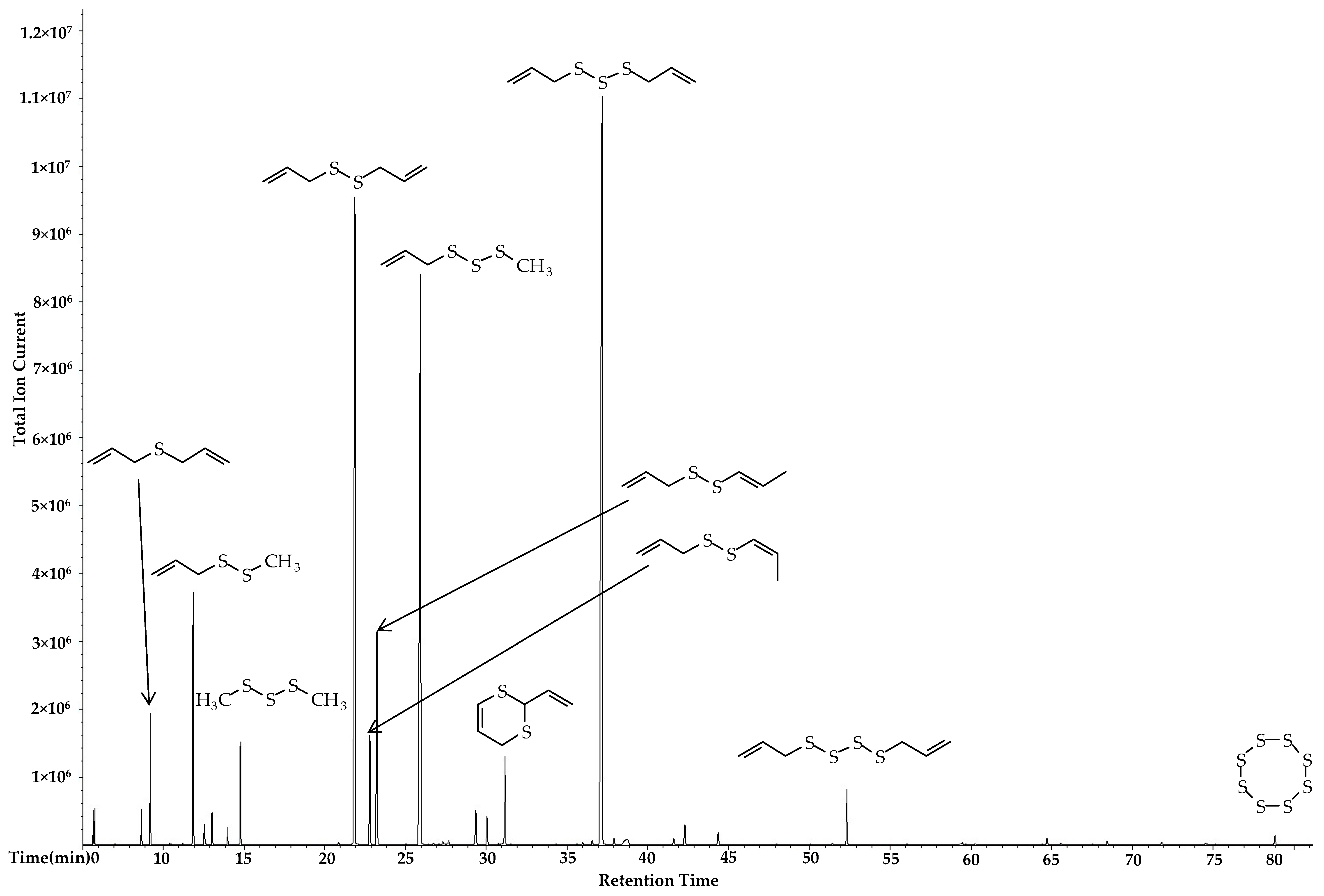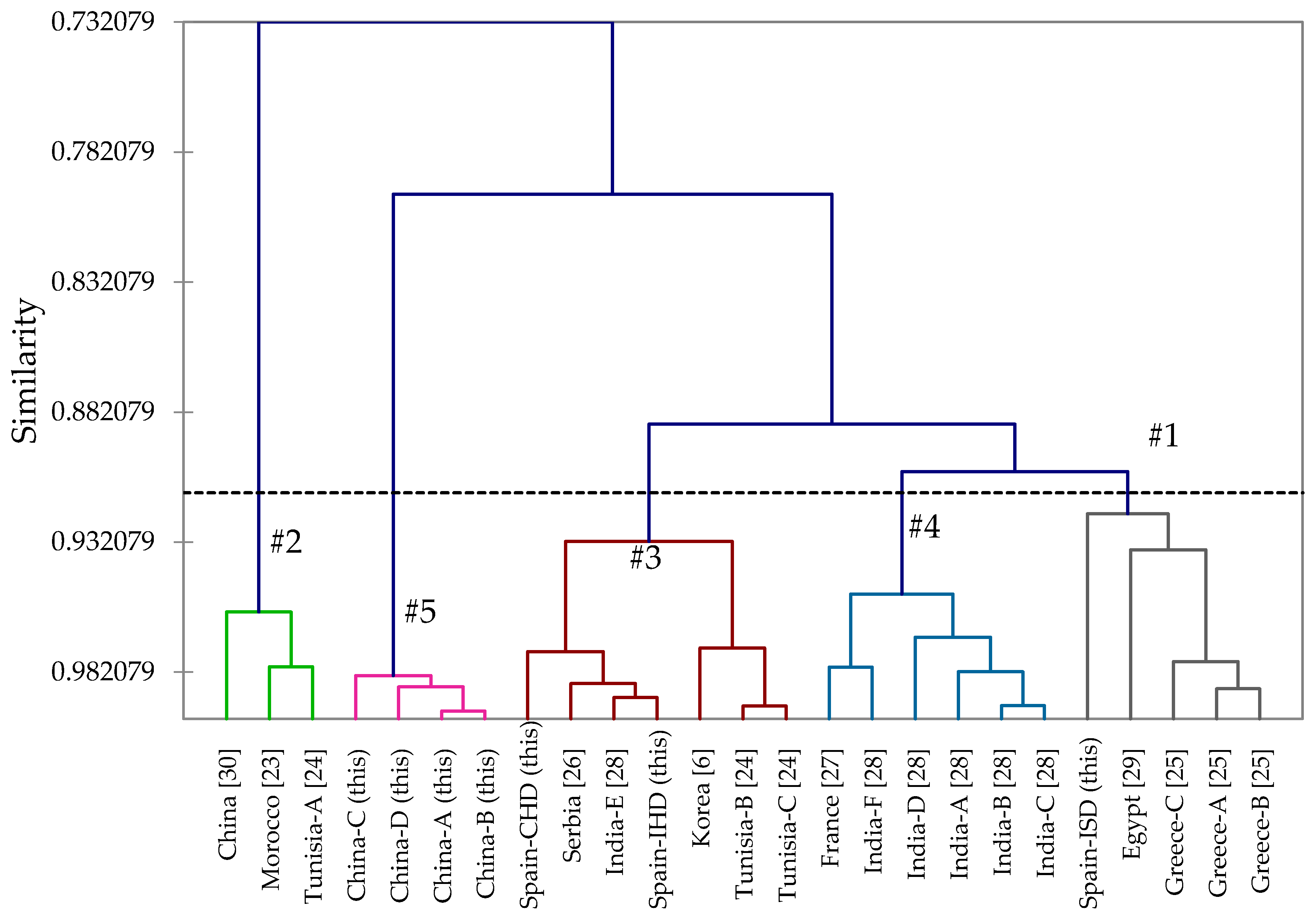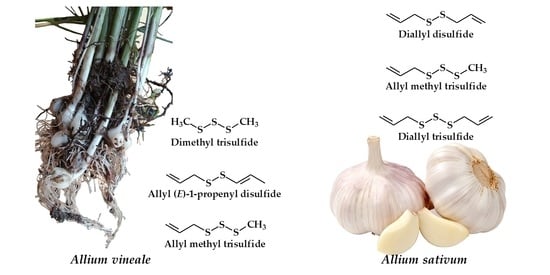The Chemical Compositions of the Volatile Oils of Garlic (Allium sativum) and Wild Garlic (Allium vineale)
Abstract
:1. Introduction
2. Materials and Methods
2.1. Plant Material
2.1.1. Allium sativum
2.1.2. Allium vineale
2.2. Gas Chromatography-Mass Spectrometry (GC-MS)
2.3. Semi-Quantitative Gas Chromatography
2.4. Hierarchical Cluster Analysis
3. Results and Discussion
3.1. Allium sativum
3.2. Allium vineale
4. Conclusions
Acknowledgments
Author Contributions
Conflicts of Interest
References
- Block, E. Garlic and Other Alliums: The Lore and the Science; Royal Society of Chemistry: Cambridge, UK, 2010. [Google Scholar]
- National Center for Complementary and Integrative Health. Garlic. Available online: https://nccih.nih.gov/health/garlic/ataglance.htm (accessed on 5 June 2017).
- Queensland Government. Allium Vineale. Available online: http://keyserver.lucidcentral.org/weeds/data/media/Html/allium_vineale.htm (accessed on 31 May 2017).
- Grieve, M. A Modern Herbal; Dover Publications: New York, NY, USA, 1971; Volume I. [Google Scholar]
- Sharifi-Rad, M.; Mnayer, D.; Tabanelli, G.; Stojanovic-Radic, Z.Z.; Sharifi-Rad, M.; Yousaf, Z.; Vallone, L.; Setzer, W.N.; Iriti, M. Plants of the genus Allium as antibacterial agents: From tradition to pharmacy. Cell. Mol. Biol. 2016, 62, 57–68. [Google Scholar] [PubMed]
- Pyun, M.S.; Shin, S. Antifungal effects of the volatile oils from Allium plants against Trichophyton species and synergism of the oils with ketoconazole. Phytomedicine 2006, 13, 394–400. [Google Scholar] [CrossRef] [PubMed]
- Lewis, W.H.; Elvin-Lewis, M.P.F. Medical Botany—Plants Affecting Man’s Health; John Wiley & Sons Ltd.: New York, NY, USA, 1977. [Google Scholar]
- Bruneton, J. Pharmacognosy, 2nd ed.; Intercept Ltd.: London, UK, 1999. [Google Scholar]
- Kunkel, G. Plants for Human Consumption: An Annotated Checklist of the Edible Phanerogams and Ferns; Koeltz Scientific Books: Königstein, Germany, 1984. [Google Scholar]
- Facciola, S. Cornucopia: A Source Book of Edible Plants; Kampong Publications: Vista, CA, USA, 1990. [Google Scholar]
- Hamel, P.B.; Chiltoskey, M.U. Cherokee Plants and Their Uses—A 400 Year History; Herald Publishing Company: Sylva, NC, USA, 1975. [Google Scholar]
- Moerman, D.E. Native American Ethnobotany; Timber Press, Inc.: Portland, OR, USA, 1998. [Google Scholar]
- Block, E. The organosulfur chemistry of the genus Allium—Implications for the organic chemistry of sulfur. Angew. Chem. Int. Ed. 1992, 104, 1158–1203. [Google Scholar] [CrossRef]
- Lanzotti, V. The analysis of onion and garlic. J. Chromatogr. A 2006, 1112, 3–22. [Google Scholar] [CrossRef] [PubMed] [Green Version]
- Satyal, P.; Murray, B.L.; McFeeters, R.L.; Setzer, W.N. Essential oil characterization of Thymus vulgaris from various geographical locations. Foods 2016, 5, 70. [Google Scholar] [CrossRef] [PubMed]
- Satyal, P.; Jones, T.H.; Lopez, E.M.; McFeeters, R.L.; Ali, N.A.A.; Mansi, I.; Al-Kaf, A.G.; Setzer, W.N. Chemotypic characterization and biological activity of Rosmarinus officinalis. Foods 2017, 6, 20. [Google Scholar] [CrossRef] [PubMed]
- Deng, G.; Craft, J.D.; Steinberg, K.M.; Li, P.L.; Pokharel, S.K.; Setzer, W.N. Influence of different isolation methods on chemical composition and bioactivities of the fruit peel oil of Citrus medica L. var. sarcodactylis (Noot.) Swingle. Medicines 2017, 4, 1. [Google Scholar]
- Adams, R.P. Identification of Essential Oil Components by Gas Chromatography/Mass Spectrometry, 4th ed.; Allured Publishing: Carol Stream, IL, USA, 2007. [Google Scholar]
- Block, E.; Iyer, R.; Grisoni, S.; Saha, C.; Belman, S.; Lossing, F.P. Lipoxygenase inhibitors from the essential oil of garlic. Markovnikov addition of the allyldithio radical to olefins. J. Am. Chem. Soc. 1988, 110, 7813–7827. [Google Scholar] [CrossRef]
- Yu, T.-H.; Wu, C.-M.; Rosen, R.T.; Hartman, T.G.; Ho, C.-T. Volatile compounds generated from thermal degradation of alliin and deoxyalliin in an aqueous solution. J. Agric. Food Chem. 1994, 42, 146–153. [Google Scholar] [CrossRef]
- Kubec, R.; Velíšek, J.; Doležal, M.; Kubelka, V. Sulfur-containing volatiles arising by thermal degradation of alliin and deoxyalliin. J. Agric. Food Chem. 1997, 45, 3580–3585. [Google Scholar] [CrossRef]
- Iranshahi, M. A review of volatile sulfur-containing compounds from terrestrial plants: Biosynthesis, distribution and analytical methods. J. Essent. Oil Res. 2012, 24, 393–434. [Google Scholar] [CrossRef]
- Douiri, L.; Boughdad, A.; Assobhei, O.; Moumni, M. Chemical composition and biological activity of Allium sativum essential oils against Callosobruchus maculatus. IOSR J. Environ. Sci. Toxicol. Food Technol. 2013, 3, 30–36. [Google Scholar] [CrossRef]
- Dziri, S.; Casabianca, H.; Hanchi, B.; Hosni, K. Composition of garlic essential oil (Allium sativum L.) as influenced by drying method. J. Essent. Oil Res. 2014, 26, 91–96. [Google Scholar] [CrossRef]
- Kimbaris, A.C.; Siatis, N.G.; Daferera, D.J.; Tarantilis, P.A.; Pappas, C.S.; Polissiou, M.G. Comparison of distillation and ultrasound-assisted extraction methods for the isolation of sensitive aroma compounds from garlic (Allium sativum). Ultrason. Sonochem. 2006, 13, 54–60. [Google Scholar] [CrossRef] [PubMed]
- Kocić-Tanackov, S.; Dimić, G.; Lević, J.; Tanackov, I.; Tepić, A.; Vujičić, B.; Gvozdanović-Varga, J. Effects of onion (Allium cepa L.) and garlic (Allium sativum L.) essential oils on the Aspergillus versicolor growth and sterigmatocystin production. J. Food Sci. 2012, 77, 278–284. [Google Scholar] [CrossRef] [PubMed]
- Mnayer, D.; Fabiano-Tixier, A.S.; Petitcolas, E.; Hamieh, T.; Nehme, N.; Ferrant, C.; Fernandez, X.; Chemat, F. Chemical composition, antibacterial and antioxidant activities of six essentials oils from the Alliaceae family. Molecules 2014, 19, 20034–20053. [Google Scholar] [CrossRef] [PubMed]
- Rao, P.G.P.; Rao, L.J.; Raghavan, B. Chemical composition of essential oils of garlic (Allium sativum L.). J. Spices Aromat. Crops 1999, 8, 41–47. [Google Scholar]
- Romeilah, R.M.; Fayed, S.A.; Mahmoud, G.I. Chemical compositions, antiviral and antioxidant activities of seven essential oils. J. Appl. Sci. Res. 2010, 6, 50–62. [Google Scholar]
- Zhao, N.N.; Zhang, H.; Zhang, X.C.; Luan, X.B.; Zhou, C.; Liu, Q.Z.; Shi, W.P.; Liu, Z.L. Evaluation of acute toxicity of essential oil of garlic (Allium sativum) and its selected major constituent compounds against overwintering Cacopsylla chinensis (Hemiptera: Psyllidae). J. Econ. Entomol. 2013, 106, 1349–1354. [Google Scholar] [CrossRef] [PubMed]
- Chekki, R.Z.; Snoussi, A.; Hamrouni, I.; Bouzouita, N. Chemical composition, antibacterial and antioxidant activities of Tunisian garlic (Allium sativum) essential oil and ethanol extract. Med. J. Chem. 2014, 3, 947–956. [Google Scholar]
- Radulović, N.S.; Miltojević, A.B.; Stojković, M.B.; Blagojević, P.D. New volatile sulfur-containing compounds from wild garlic (Allium ursinum L., Liliaceae). Food Res. Int. 2015, 78, 1–10. [Google Scholar] [CrossRef] [PubMed]
- Motsei, M.L.; Lindsey, K.L.; Van Staden, J.; Jäger, A.K. Screening of traditionally used South African plants for antifungal activity against Candida albicans. J. Ethnopharmacol. 2003, 86, 235–241. [Google Scholar] [CrossRef]
- Ledezma, E.; Apitz-Castro, R. Ajoene, el principal compuesto activo derivado del ajo (Allium sativum), un nuevo agente antifúngico. Rev. Iberoam. Micol. 2006, 23, 75–80. [Google Scholar] [CrossRef]
- Ross, Z.M.; O’Gara, E.A.; Hill, D.J.; Sleightholme, H.V.; Maslin, D.J. Antimicrobial properties of garlic oil against human enteric bacteria: Evaluation of methodologies and comparisons with garlic oil sulfides and garlic powder. Appl. Environ. Microbiol. 2001, 67, 475–480. [Google Scholar] [CrossRef] [PubMed]
- Benkeblia, N. Antimicrobial activity of essential oil extracts of various onions (Allium cepa) and garlic (Allium sativum). LWT Food Sci. Technol. 2004, 37, 263–268. [Google Scholar] [CrossRef]
- El-Zemity, S.; Rezk, H.; Farok, S.; Zaitoon, A. Acaricidal activities of some essential oils and their monoterpenoidal constituents against house dust mite, Dermatophagoides pteronyssinus (Acari: Pyroglyphidae). J. Zhejiang Univ. Sci. B 2006, 7, 957–962. [Google Scholar]
- Zenner, L.; Callait, M.P.; Granier, C.; Chauve, C. In vitro effect of essential oils from Cinnamomum aromaticum, Citrus limon and Allium sativum on two intestinal flagellates of poultry, Tetratrichomonas gallinarum and Histomonas meleagridis. Parasite 2003, 10, 153–157. [Google Scholar] [CrossRef] [PubMed]
- Ayaz, E.; Turel, I.; Gul, A.; Yilmaz, O. Evaluation of the anthelmentic activity of garlic (Allium sativum) in mice naturally infected with Aspiculuris tetraptera. Recent Pat. Antiinfect. Drug Discov. 2008, 3, 149–152. [Google Scholar] [CrossRef] [PubMed]
- Abbas, S.; Dawar, S.; Tariq, M.; Zaki, M.J. Nematicidal activity of spices against Meloidogyne javanica (Treub) Chitwood. Pak. J. Bot. 2009, 41, 2625–2632. [Google Scholar]
- Park, I.L.K.; Shin, S.C. Fumigant activity of plant essential oils and components from garlic (Allium sativum) and clove bud (Eugenia caryophyllata) oils against the Japanese termite (Reticulitermes speratus Kolbe). J. Agric. Food Chem. 2005, 53, 4388–4392. [Google Scholar] [CrossRef] [PubMed]
- Chaubey, M.K. Insecticidal effect of Allium sativum (Alliaceae) essential oil. J. Biol. Act. Prod. Nat. 2013, 3, 248–258. [Google Scholar]
- Jain, R.C.; Vyas, C.R.; Mahatma, O.P. Hypoglycemic action of onion and garlic. Lancet 1973, 2, 1491. [Google Scholar] [CrossRef]
- Bordia, A.; Bansal, H.C.; Arora, S.K.; Singh, S.V. Effect of the essential oils of garlic and onion on alimentary hyperlipemia. Atherosclerosis 1975, 21, 15–20. [Google Scholar] [CrossRef]
- Amagase, H.; Petesch, B.L.; Matsuura, H.; Kasuga, S.; Itakura, Y. Recent advances on the nutritional effects associated with the use of garlic as a supplement. J. Nutr. 2001, 131, 955S–962S. [Google Scholar] [PubMed]
- Tsai, T.H.; Tsai, P.J.; Ho, S.C. Antioxidant and anti-inflammatory activities of several commonly used spices. J. Food Sci. 2005, 70, C93–C97. [Google Scholar] [CrossRef]
- Tsao, S.M.; Yin, M.C. In-vitro antimicrobial activity of four diallyl sulphides occurring naturally in garlic and Chinese leek oils. J. Med. Microbiol. 2001, 50, 646–649. [Google Scholar] [CrossRef] [PubMed]
- Kim, J.W.; Huh, J.E.; Kyung, S.H.; Kyung, K.H. Antimicrobial activity of alk(en)yl sulfides found in essential oils of Allium sativum and onion. Food Sci. Biotechnol. 2004, 13, 235–239. [Google Scholar]



| Sample | #1 a | #2 | #3 | #4 |
|---|---|---|---|---|
| Mass of plant material (g) | 94.04 | 123.29 | 98.20 | 72.35 |
| Mass of essential oil (mg) | 87.2 | 258.5 | 210.5 | 25.3 |
| Essential oil yield | 0.0927% | 0.2097% | 0.2144% | 0.0350% |
| RI a | Compound | Percent Composition | ||
|---|---|---|---|---|
| Clevenger-Type Hydrodistillation | Industrial Steam Distillation | Industrial Hydrodistillation | ||
| 739 | Dimethyl disulfide | 0.4 | 1.4 | - b |
| 741 | 2-Methyl-4-pentenal | tr c | 0.1 | - |
| 743 | 2-Methylene-4-pentenal | 0.4 | - | - |
| 787 | 3-Methylthiophene | - | 0.1 | - |
| 801 | Hexanal | tr | 0.1 | - |
| 842 | 1,2-Dithiolane | 0.5 | 0.3 | 0.4 |
| 855 | Diallyl sulfide | 1.9 | 9.5 | 3.4 |
| 870 | Allyl propyl sulfide | - | 0.1 | - |
| 886 | Allyl (Z)-1-propenyl sulfide | tr | tr | tr |
| 889 | Allyl (E)-1-propenyl sulfide | tr | - | - |
| 904 | 3,4-Dimethylthiophene | tr | 0.2 | 0.1 |
| 916 | Allyl methyl disulfide | 4.4 | 8.3 | 5.2 |
| 928 | Methyl (Z)-1-propenyl disulfide | 0.4 | 0.4 | 0.4 |
| 936 | Methyl (E)-1-propenyl disulfide | 0.6 | 0.7 | 0.6 |
| 953 | 1,2-Dithiolene | 0.3 | 0.1 | 0.4 |
| 968 | Dimethyl trisulfide | 2.0 | 2.9 | 1.3 |
| 1080 | Diallyl disulfide | 20.8 | 27.9 | 25.9 |
| 1093 | Allyl (Z)-1-propenyl disulfide | 2.6 | 2.2 | 2.6 |
| 1100 | Allyl (E)-1-propenyl disulfide | 5.2 | 3.7 | 4.6 |
| 1138 | Allyl methyl trisulfide | 19.2 | 17.7 | 14.5 |
| 1149 | Methyl propyl trisulfide | - | - | tr |
| 1153 | 4-Methyl-1,2,3-trithiolane | tr | 1.2 | 0.5 |
| 1159 | Methyl (Z)-1-propenyl trisulfide | 0.1 | - | 0.1 |
| 1164 | Methyl (E)-1-propenyl trisulfide | 0.1 | - | 0.1 |
| 1188 | 3-Vinyl-4H-1,2-dithiine | 0.9 | 0.8 | 0.6 |
| 1198 | 1,2,3-Trithia-4-cyclohexene | 0.7 | 0.4 | 0.6 |
| 1208 | Allicin | tr | - | tr |
| 1214 | 2-Vinyl-4H-1,3-dithiine | 2.5 | 1.8 | 2.0 |
| 1292 | Methyl (methylsulfinyl)methyl sulfide d | 0.1 | 0.1 | 0.1 |
| 1301 | Diallyl trisulfide | 33.4 | 16.8 | 31.2 |
| 1313 | Allyl propyl trisulfide | 0.2 | 0.3 | 0.2 |
| 1325 | Allyl (E)-1-propenyl trisulfide | - | - | 0.4 |
| 1369 | 5-Methyl-1,2,3,4-tetrathiane | 0.2 | 0.4 | 0.6 |
| 1379 | Unidentified e | 0.5 | 0.7 | 0.7 |
| 1411 | 1,4-Dihydro-2,3-benzoxathiin 3-oxide | 0.4 | 0.2 | 0.2 |
| 1443 | [(E)-1-Propenyl] 2-thiopent-3-yl disulfide d | - | 0.2 | - |
| 1540 | Diallyl tetrasulfide | 1.5 | 1.0 | 2.2 |
| 1591 | Propyl 4-thiohept-2-en-5-yl disulfide d | - | 0.2 | - |
| 1646 | 4-Methyl-1,2,3,5,6-pentathiepane c | - | 0.1 | 0.2 |
| 2041 | Cyclooctasulfur | 0.3 | 0.1 | 0.4 |
| Total Identified | 99.2 | 98.9 | 99.0 | |
| Sulfur-containing | 99.3 | 99.4 | 99.5 | |
| RI a | Compound | Percent Composition | |||
|---|---|---|---|---|---|
| #1 b | #2 | #3 | #4 | ||
| 837 | 2-Furaldehyde | 2.2 | 1.0 | 1.3 | 1.3 |
| 854 | (2E)-Hexenal | 0.8 | 2.0 | 1.9 | 2.0 |
| 856 | (3Z)-Hexenol | tr c | 1.4 | tr | tr |
| 902 | 2,4-Dimethylthiophene | 0.8 | 1.7 | 2.0 | 2.2 |
| 915 | Allyl methyl disulfide | 6.1 | 3.6 | 2.3 | 2.3 |
| 930 | Methyl (Z)-1-propenyl disulfide | 3.1 | 1.1 | 1.3 | 1.5 |
| 939 | Methyl (E)-1-propenyl disulfide | 12.5 | 3.2 | 2.6 | 3.0 |
| 958 | Benzaldehyde | tr | 0.6 | 4.2 | 16.4 |
| 965 | Dimethyl trisulfide | 17.4 | 3.8 | 4.4 | 4.3 |
| 1079 | Diallyl disulfide | 6.3 | 12.2 | 4.4 | 5.2 |
| 1091 | Allyl (Z)-1-propenyl disulfide | 3.1 | 4.3 | 3.4 | 2.8 |
| 1099 | Allyl (E)-1-propenyl disulfide | 11.6 | 12.5 | 7.9 | 8.2 |
| 1115 | 1-Propenyl propyl disulfide d,e | 1.4 | 2.0 | 1.9 | 1.7 |
| 1123 | Methyl methylthiomethyl disulfide | tr | 0.5 | 1.2 | 0.8 |
| 1135 | Allyl methyl trisulfide | 13.2 | 9.9 | 9.9 | 7.9 |
| 1147 | 4-Methyl-1,2,3-trithiolane d | tr | 1.8 | 1.0 | 1.6 |
| 1149 | Methyl propyl trisulfide | tr | 1.9 | 2.7 | 1.8 |
| 1158 | Methyl (Z)-1-propenyl trisulfide | 1.9 | 0.5 | 1.4 | 0.9 |
| 1164 | Methyl (E)-1-propenyl trisulfide | 2.7 | 1.0 | 1.7 | 1.5 |
| 1211 | Dimethyl tetrasulfide | 4.0 | 0.8 | 1.2 | 1.1 |
| 1284 | Allyl methylthiomethyl disulfide d | tr | 2.3 | 2.6 | 1.9 |
| 1291 | Diallyl trisulfide | 2.8 | 10.5 | 7.9 | 5.3 |
| 1302 | Allyl (Z)-1-propenyl trisulfide | tr | 3.0 | 2.7 | 2.3 |
| 1309 | p-Vinylguaiacol | 5.3 | 5.2 | 6.5 | 5.4 |
| 1320 | Allyl propyl trisulfide | tr | 1.1 | 2.4 | 2.2 |
| 1344 | 5-Methyl-1,2,3,4-tetrathiane d | tr | 5.5 | 6.1 | 4.3 |
| 1346 | Methyl methylthiomethyl trisulfide | tr | 0.7 | 1.0 | 1.5 |
| 1364 | Allyl methyl tetrasulfide | 2.4 | 1.6 | 2.4 | 1.8 |
| 1483 | Allyl methylthiomethyl trisulfide d | tr | 0.5 | 1.2 | 0.9 |
| 1599 | Unidentified f | 1.6 | 1.7 | 4.6 | 3.3 |
| 1623 | 4-Methyl-1,2,3,5,6-pentathiepane d | tr | 0.5 | 2.0 | 1.2 |
| 1754 | Unidentified g | 0.6 | 2.0 | 4.1 | 3.2 |
| Total Identified | 97.8 | 96.2 | 91.4 | 93.5 | |
| Sulfur-containing | 91.6 | 90.0 | 86.1 | 74.9 | |
© 2017 by the authors. Licensee MDPI, Basel, Switzerland. This article is an open access article distributed under the terms and conditions of the Creative Commons Attribution (CC BY) license (http://creativecommons.org/licenses/by/4.0/).
Share and Cite
Satyal, P.; Craft, J.D.; Dosoky, N.S.; Setzer, W.N. The Chemical Compositions of the Volatile Oils of Garlic (Allium sativum) and Wild Garlic (Allium vineale). Foods 2017, 6, 63. https://doi.org/10.3390/foods6080063
Satyal P, Craft JD, Dosoky NS, Setzer WN. The Chemical Compositions of the Volatile Oils of Garlic (Allium sativum) and Wild Garlic (Allium vineale). Foods. 2017; 6(8):63. https://doi.org/10.3390/foods6080063
Chicago/Turabian StyleSatyal, Prabodh, Jonathan D. Craft, Noura S. Dosoky, and William N. Setzer. 2017. "The Chemical Compositions of the Volatile Oils of Garlic (Allium sativum) and Wild Garlic (Allium vineale)" Foods 6, no. 8: 63. https://doi.org/10.3390/foods6080063







